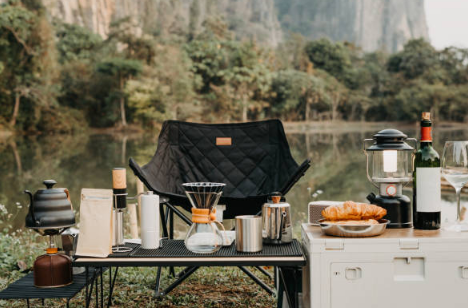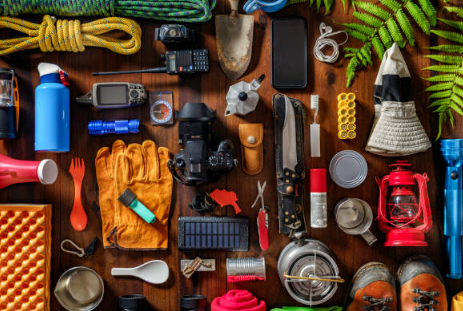Our precious Earth is filled with stuff. Some of it we use daily, some only occasionally—but it’s all around us. Take camping gear, for example. It’s essential when you’re out in nature, but often sits untouched the rest of the year. So, if you’re only heading out a few times a year, do you really need to buy brand-new outdoor equipment? If not, what’s the alternative—and is it worth it?
Buying or sourcing secondhand camping and outdoor gear is a smart way to combat the growing problem of overconsumption. In this article, we’ll explore why choosing used outdoor gear is often the better option compared to buying the latest, shiniest new models—and we’ll share practical ways to find high-quality used gear that can last for years.
Why Buy Used Outdoor Gear?
Sure, buying used gear may seem risky. Performance, fit, and function are crucial when you’re spending time—or even surviving—in the outdoors. In some situations, it makes sense to buy new, especially if you need something specific or gear that wears out quickly. But in many cases, going secondhand is a smart, sustainable, and budget-friendly move. Here’s why:
1. It Saves You Money
Used camping and outdoor gear is typically much cheaper than new. Many items are lightly used—sometimes barely at all—so snagging a great deal is super satisfying.
2. It’s Better for the Planet
Used gear is a win for the environment. So much outdoor gear is made with synthetic materials (like plastics) that take decades—sometimes centuries—to decompose. For instance, a polyester shirt can take 20 to 200 years to break down. Buying used helps reduce demand for new production, cuts down on petroleum use, and keeps chemicals and dyes out of our waterways—all while saving water and energy.
3. You Can Afford Gear You Couldn’t Justify at Full Price
Let’s face it: outdoor gear can be cool. But sometimes the price tags are ridiculous. With used gear, you can experiment with top-tier equipment—maybe even something you’d never dream of buying new. Many people upgrade their gear regularly, leaving barely-used items up for grabs. Rental shops also cycle out great equipment at affordable prices.
4. You’ll Find More Reviews on Older Gear
Every season, new gear hits the market. If you’re buying new, it’s hard to tell what’s worth the money. But if you’re buying gear that’s a couple of seasons old, odds are there are plenty of reviews available. That gives you confidence and insight to make smarter purchasing decisions.
5. You Can Test What Works for You Before Investing Big
If you’re new to camping or trying a new outdoor hobby, it’s hard to know what gear you’ll truly need. Renting or buying used lets you test different styles and brands before committing. Try out a few models on your first few trips, and only invest when you’ve figured out what really works for you.
9 Smart Ways to Get Secondhand Outdoor Gear
The outdoor industry is slowly waking up to the need for change. The more we support reuse, repair, and recycling, the more quality gear stays in circulation—making the outdoors more accessible and affordable for everyone.
1. Borrow Gear
If you’ve got friends or family who camp, hike, or paddle, ask if they’ll lend you something. It’s perfect for one-off trips or figuring out what gear suits you. No luck with personal connections? Try local forums, lending libraries, or gear-sharing groups. You might be surprised how generous strangers can be.
2. Thrift Stores & Consignment Shops
Local thrift and consignment stores can be treasure troves for outdoor gear. Quality varies, but if you’re willing to dig, you’ll often score solid items at bargain prices. Plus, buying from these shops supports local causes and nonprofits.

3. Rent Gear
Gear rentals are great when storage space is limited, or you only need something once in a while. Rentals reduce the need for new gear production while letting you try high-quality items before buying. Think snowshoes, paddleboards, climbing gear—renting first just makes sense.
4. Buy Used from Online Outdoor Retailers
There are online marketplaces dedicated to secondhand outdoor gear—some even operate like eBay, but just for outdoor enthusiasts. Check out sites like Switchback, where you can buy and sell gear with confidence.
5. Shop Used Sections from Major Outdoor Brands
Big brands like Patagonia, REI, and Arc’teryx have embraced resale. They refurbish gently-used items and resell them at a discount. You’ll find great gear that may be a season or two old but still built to last.
6. Freecycle & Other Free Gear Platforms
Freecycle and similar networks let you give and get stuff for free. Once you sign up, you’ll get daily emails about what people in your area are giving away—camping gear often pops up! You can also post requests and see if anyone has what you need.
7. eBay
eBay is a goldmine for secondhand outdoor gear. Search by size, brand, or gear type. Whether you’re hunting for a budget tent or gently-used hiking boots, the variety is huge. You can also sell your old gear to fund new adventures.
8. Amazon (Yes, Really!)
Amazon has a “used” section that many shoppers overlook. You can filter your search results to show only used items. While it’s not as gear-focused as other sites, you can still find some decent deals.
9. Campsite Trash (Seriously)
It might sound weird, but campsite dump areas can be a source of abandoned but still usable gear. People often toss things like folding chairs or sleeping pads that need minor repairs. You don’t need to dig through garbage—just keep an eye out near the dumpsters before you leave.
The Bottom Line:
Choosing to rent or buy secondhand gear is a smart move—for your wallet and the planet. Still, there are times when buying new makes sense. When you do go that route, try to support brands that prioritize sustainability, recycled materials, and ethical practices.
Outdoor adventures don’t have to come at a high cost. With a little creativity and a willingness to reuse, you can explore the great outdoors with gear that’s affordable, functional, and environmentally responsible.

